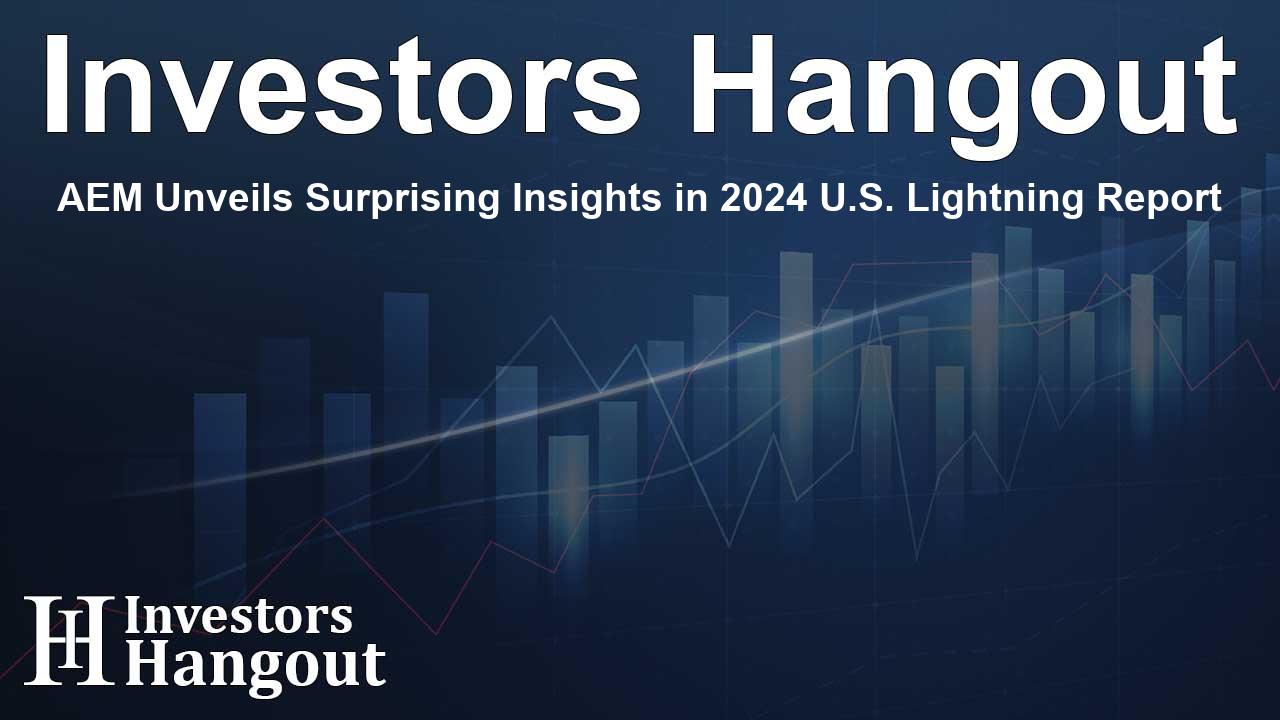AEM Unveils Surprising Insights in 2024 U.S. Lightning Report

AEM Unveils Surprising Insights in 2024 U.S. Lightning Report
AEM, known for its vital role in providing environmental insights, has recently made waves with the release of its 2024 U.S. Lightning Report. This report paints a vivid picture of a changing landscape when it comes to lightning activity across the United States. Notably, the analysis shows a remarkable decrement of 17.7% from the year prior, with over 459 million lightning pulses recorded in 80 million flashes.
Unprecedented Patterns of Lightning Activity
The report has unearthed an extraordinary occurrence where typical weather patterns have been disrupted. States in the Midwest, known for their mild weather conditions, are now experiencing levels of lightning activity similar to those typically observed in areas like Dixie Alley and Tornado Alley. This shift not only reflects a significant change in weather behavior but also raises questions about potential long-term impacts on severe weather patterns throughout the country.
Midwest Storm Seasons See Record Highs
Illinois and Iowa are at the forefront of this lightning evolution, finding themselves unexpectedly recognized for their elevated levels of lightning flash density. Both states have seen startling increases: Illinois jumped from 17th to a prominent position among the top 10 states for lightning density, while Iowa surged from 21st. These changes highlight a shift in what once were typical patterns of lightning activity.
Storm Activity Drives the Anomaly
What has spurred this change? The answer lies in the unusually active storm seasons in the Upper Midwest. In 2024, Iowa achieved an impressive milestone with 125 tornadoes, while Illinois recorded over 100 tornadoes by mid-July, surpassing its annual average. Over just two days in July, Chicago was struck by 41 tornadoes due to an extensive storm system. This surge in tornado activity correlates with significant jumps in lightning occurrences, as evidenced by a 24% rise in Iowa and a 9% increase in Illinois, compared to the previous year.
Key Findings from the 2024 Report
Among the many highlights of the report:
- Top States by Flash Density: Florida remains the leader with 76 flashes per square mile, followed closely by Louisiana, Oklahoma, and Kansas.
- Top Counties by Flash Density: St. Bernard Parish in Louisiana stands out, boasting a remarkable flash density of 266 flashes per square mile, far exceeding other counties throughout the nation.
- Dangerous Thunderstorm Alerts (DTAs): The state of Texas has reported the highest number of DTAs in the country, with over 6,800 alerts recorded in 2024 alone.
Dr. Elizabeth DiGangi, a noted lightning expert at AEM, commented, "The emergence of Illinois and Iowa in the ranks of states with the highest annual flash density represents a fascinating evolution in lightning behavior we've been observing. Traditionally, the Southeast and Gulf Coast regions dominate these rankings, but the data from 2024 suggests a shift in severe weather patterns within the U.S."
The Role of AEM's Lightning Detection Network
The information contained in the 2024 U.S. Lightning Report was gathered using AEM's Earth Networks Total Lightning Network (ENTLN), one of the most comprehensive global networks dedicated to lightning detection. With an impressive configuration of over 1,800 sensors globally, the ENTLN is instrumental in enhancing our understanding of environmental threats and modeling better responses.
About AEM
AEM's mission focuses on uniting technology leaders across the globe to empower communities by delivering insights that help them adapt and respond effectively to growing environmental challenges. Through the implementation of advanced sensing networks and a secure data management framework, alongside valuable analytics for users, AEM serves a crucial function in helping mitigate environmental threats. These efforts are pivotal in fostering positive environmental outcomes, aiming to safeguard our planet for future generations.
Frequently Asked Questions
What does the 2024 U.S. Lightning Report reveal?
The report indicates an unusual increase in lightning activity in the Midwest, with Illinois and Iowa experiencing significant rises in lightning density.
How did Iowa and Illinois rank in the report?
Iowa and Illinois now rank among the top states for lightning flash density in 2024, a notable shift from previous years.
What factors contributed to the increased lightning activity?
The surge in tornadoes and intense storm seasons in these states has directly correlated with the rise in lightning activity.
Which states have the highest flash densities?
Florida retains the highest flash density, followed by Louisiana, Oklahoma, and Kansas according to the report's findings.
What is AEM's Earth Networks Total Lightning Network?
AEM's ENTLN is a global lightning detection network comprising over 1,800 sensors, crucial for understanding and predicting environmental risks.
About Investors Hangout
Investors Hangout is a leading online stock forum for financial discussion and learning, offering a wide range of free tools and resources. It draws in traders of all levels, who exchange market knowledge, investigate trading tactics, and keep an eye on industry developments in real time. Featuring financial articles, stock message boards, quotes, charts, company profiles, and live news updates. Through cooperative learning and a wealth of informational resources, it helps users from novices creating their first portfolios to experts honing their techniques. Join Investors Hangout today: https://investorshangout.com/
Disclaimer: The content of this article is solely for general informational purposes only; it does not represent legal, financial, or investment advice. Investors Hangout does not offer financial advice; the author is not a licensed financial advisor. Consult a qualified advisor before making any financial or investment decisions based on this article. The author's interpretation of publicly available data shapes the opinions presented here; as a result, they should not be taken as advice to purchase, sell, or hold any securities mentioned or any other investments. The author does not guarantee the accuracy, completeness, or timeliness of any material, providing it "as is." Information and market conditions may change; past performance is not indicative of future outcomes. If any of the material offered here is inaccurate, please contact us for corrections.